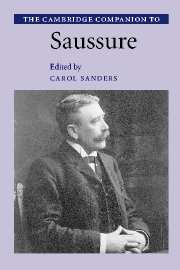Book contents
- Frontmatter
- Introduction: Saussure today
- Part I Out of the nineteenth century
- Part II The ‘Course in General Linguistics’
- Part III After the Cours
- 7 Saussure and American linguistics
- 8 Saussure and structuralist linguistics in Europe
- 9 The Russian critique of Saussure
- 10 Saussure, Barthes and structuralism
- 11 Saussure’s anagrams
- 12 Saussure and Derrida
- Part IV New debates and directions
- Notes
- Works by Saussure and further reading
- References
- Index
11 - Saussure’s anagrams
from Part III - After the Cours
Published online by Cambridge University Press: 28 May 2006
- Frontmatter
- Introduction: Saussure today
- Part I Out of the nineteenth century
- Part II The ‘Course in General Linguistics’
- Part III After the Cours
- 7 Saussure and American linguistics
- 8 Saussure and structuralist linguistics in Europe
- 9 The Russian critique of Saussure
- 10 Saussure, Barthes and structuralism
- 11 Saussure’s anagrams
- 12 Saussure and Derrida
- Part IV New debates and directions
- Notes
- Works by Saussure and further reading
- References
- Index
Summary
For a long time Ferdinand de Saussure has been considered the source of the Cours de linguistique générale, and to better-informed scholars he was also the author of important Indo-European studies, among which the Mémoire sur le système primitif des voyelles dans les langues indo-européennes holds a particularly high rank. Only about fifty years after his death, another field of research was discovered, one that has - at the first glimpse - hardly anything in common with the other two. In the search for the sources of the vulgate version of the Cours, eight cardboard boxes of notebooks and sketches were found, which dealt with the anagrammatical components of Indo-European (and particularly Latin) poetry. Starting with the phenomenon of the anagram and some other similar phenomena, Saussure tried to develop a general theory of poetry. This almost obsessive interest also influenced his correspondence with Antoine Meillet, Léopold Gautier and Giovanni Pascoli (Wunderli, 1972b: 36, n.5). As in the case of the CLG, he never published anything on this topic during his lifetime. This is not necessarily a cause for regret because - from a contemporary point of view - the theory of anagrams as developed in Saussure's notes is not adequate. This, however, does not mean that we can simply consider the matter closed. As soon as this work became known, avant-garde French literary theorists of the late 1960s and the early 1970s received it enthusiastically and integrated it in their own approaches. These were basically the authors around the journal Tel Quel: Julia Kristéva (1969a and 1969b), Philippe Sollers (Ponge/Sollers, 1970), Jacques Derrida, Jean Ricardou and others (Wunderli, 1972a: 37). Although Saussure's anagram theory proved to be inadequate for its original object, Indo-European poetry, it became almost indispensable for modern literature and literary theory. So Saussure even achieved fame posthumously in the field of literary studies!
- Type
- Chapter
- Information
- The Cambridge Companion to Saussure , pp. 174 - 185Publisher: Cambridge University PressPrint publication year: 2004
- 5
- Cited by



